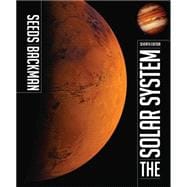With this revised edition of THE SOLAR SYSTEM, Michael Seeds' goal is to help students use astronomy to understand science and use science to understand what we are. Fascinating and engaging, this text illustrates the scientific method and guides students to answer these fundamental questions: What are we? How do we know? In discussing the interplay between evidence and hypothesis, Seeds provides not only facts but also a conceptual framework for understanding the logic of science. This edition addresses the newest developments and latest discoveries in the exciting study of astronomy, including new data on Jupiter's ring system; new evidence of dark energy, quasars, and galaxy collisions; and a look inside supernova explosions.
Features:
-Seeds' thematic emphasis on the scientific method stands out in two recurring text features. "How Do We Know?" boxes draw on examples of great moments in science from various disciplines to illustrate the logical processes scientists use to learn about nature. The "Scientific Argument" feature at the end of each section contains a carefully designed question to help students review the key concepts. A short answer follows each question to emphasize how scientists construct logical arguments from observations, evidence, theories, and natural laws. An additional question gives students a chance to construct their own argument on a related issue.
-For the seventh edition, several elements have been designed to help students develop a stronger understanding of the big picture. Chapter opening "Guideposts" connect previous and subsequent chapters to the material students are about to read, highlighting the "essential questions" within that chapter. These essential questions act as the organizing elements in the chapter summaries to encourage students to gain a deeper understanding of the material rather than just memorize a list of facts.
-Seeds' unique art program showcases this visual science in a consistent, striking new style. The hallmark Concept Art Spreads are numbered and emphasized in text narratives, making these two-page visual summaries easy to analyze and synthesize. Concept Figures marry art and text, encouraging students to synthesize information as a unified concept. Guided Discovery Figures lead students through several frames of art to demonstrate processes that occur over time and provide brief guiding comments explaining each frame. To help students understand the main idea at a glance, all H-R diagrams are consistently designed.
-Two different CD-based planetarium software options are available on request, allowing instructors more flexibility when designing their course. Choose from TheSky Student Edition or Starry Night.
-Available on request with the text are two innovative technology enhancements. Virtual Astronomy Labs focus on 20 of the most important concepts in astronomy, offering students hands on exercises that complement text topics. Instructors can set up classes online and view student results, or students can print their lab reports for submission, making the Virtual Astronomy Labs ideal for homework assignments, lab exercises, and extra credit work.








